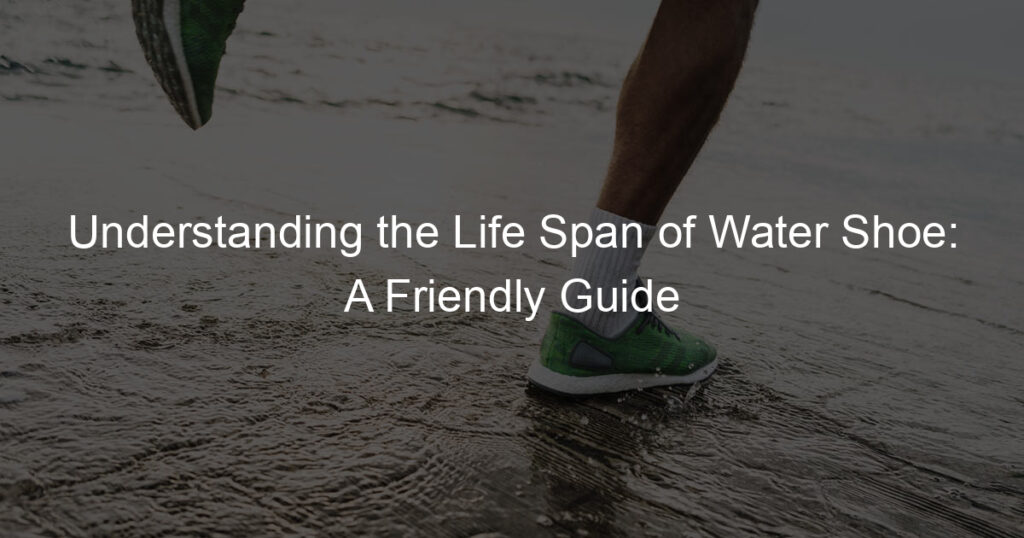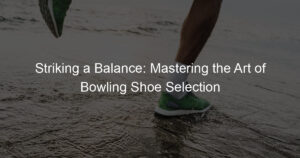Water shoes provide great utility, offering protection and support when navigating wet and slippery environments.
I’ve often wondered how long my water shoes would last. This article aims to explore the typical life span of water shoe, ensuring you get the most out of your investment.
In order to understand the longevity of water shoes, we need to dive into the various factors that impact their durability. These include materials used, special features, the different styles and models offered by popular brands, and, of course, proper care and maintenance.
We’ll also examine price and value to ensure you make the right choice when selecting a pair.
Key Takeaways
- Quality materials and maintenance practices can greatly affect a water shoe’s lifespan
- Comfort, fit, and special features are essential for choosing the right pair
- Balancing price and value helps to find the best water shoe for your needs
Understanding the Life Span of Water Shoe
As an outdoor enthusiast, I’ve found that water shoes are an essential part of my gear collection. They provide support and protection for various water-based activities like kayaking, canoeing, rafting, fishing, and even beach walks.
In these adventures, it’s essential to have lightweight shoes that protect my feet from rocks, sand, and slippery surfaces.
When choosing water shoes, I discovered the importance of considering the materials used. Most models consist of mesh and fabric that are both breathable and offer a quick-drying feature.
These materials allow for excellent water drainage, keeping my feet comfortable and reducing the chances of slipping.
In addition to breathability, water shoes are also designed to provide good arch support and cushioning, which makes them versatile and useful, even for light running in wet terrain.
Another critical factor when it comes to water shoes is their durability. In my experience, the best water shoes are not just waterproof but resistant to wear and tear, providing foot protection for a variety of aquatic adventures.
Most models have reinforced soles for better traction on slippery or uneven surfaces, which increases safety during activities like paddleboarding, snorkeling, and diving.
In my quest for the perfect pair of water shoes, I have also found that grip and traction are crucial features. To ensure stability in wet and slippery conditions, water shoes typically have rubber soles with unique patterns, providing excellent traction and grip on various surfaces, such as rocks in a river or sand at the beach.
A great grip makes any water activity safer and more enjoyable, whether it’s boating or simply exploring the shoreline.
Lastly, the ease of use is a practical feature of any water shoe. Slip-on water shoes have been lifesavers on many occasions, providing convenience during travel and the ease of quickly taking them on and off.
This feature allows me to enjoy my activities more because I can simply focus on the fun and not worry about complicated closures or adjustments.
Water shoes bring comfort, protection, and versatility to all my aquatic adventures. They are designed with lightweight materials, provide adequate support, and ensure excellent traction on various surfaces.
Having a reliable pair in my collection has made a significant difference in how much I enjoy my water-based activities.
Various Styles and Models
When it comes to water shoes, there are plenty of styles and models to choose from. Many of these designs cater to specific needs and preferences.
I’ve noticed that some water shoes resemble traditional running shoes, providing extra support and cushioning for those who enjoy water sports or beachside games.
These kinds of running shoes are great for protecting your feet from rough terrain and sharp objects while keeping water from getting trapped inside.
Sandals also come in various styles tailored for water activities. They often have straps that allow you to adjust the fit, making them perfect for individuals with different foot shapes. This feature also ensures that my sandals don’t slide off when I’m in the water.
Some sandals even come with extra support features, like arch support which helps alleviate the pain associated with plantar fasciitis.
Another popular type of water shoe is the flip-flop. While these might not offer as much support as other models, they are perfect for casual beach outings and are easy to slip on and off. Flip-flops also work well for individuals who prefer minimal footwear during their water activities.
No matter which style I choose, it’s important to consider the purpose and environment in which I’ll be using them. By considering these factors, I can select the perfect pair of water shoes for my needs while enjoying the various models available.
Materials and Durability
When I think about water shoes, the materials they’re made of play a crucial role in their lifespan. Most water shoes consist of a combination of neoprene, leather, and ethylene vinyl acetate (EVA) materials.
Let me give you a brief idea of why these materials are commonly used in water shoes and how they impact durability.
Neoprene is a synthetic rubber material that is commonly used in water shoes due to its water-resistant and insulating properties. It provides good cushioning and protection for our feet when we’re walking on wet surfaces.
One of the great features I’ve noticed is neoprene’s flexibility, which allows for a comfortable fit and ease of movement.
Nevertheless, it’s important to keep in mind that exposure to sunlight or excessive heat may cause the neoprene to degrade over time, thus affecting the durability of the water shoes.
On the other hand, leather is another popular material used in water shoes, especially in the upper part of the shoe. It offers excellent durability, flexibility, and water-resistant properties.
Leather water shoes usually have reinforcement in high-wear areas, ensuring longevity. I always find leather water shoes to be a perfect choice for optimal performance, especially when involved in water-related activities like river walks and water aerobics.
Furthermore, many water shoes use ethylene vinyl acetate (EVA) as the primary material in their midsoles and outsoles. EVA is a lightweight, durable, flexible, and shock-absorbing foam that offers excellent cushioning for our feet.
In my experience, EVA outsoles have provided me with excellent grip on slippery surfaces, and they dry quickly after use.
To maintain the durability of my water shoes, I always make sure to rinse them with fresh water after use to remove any salt, chlorine, or debris. I also let them air-dry away from direct sunlight to prevent any damage to the materials.
By taking care of my water shoes this way, I’ve found that they tend to last quite a while, ensuring I get the most value and performance out of my investment.
The life span of water shoes depends on the materials used, the level of care, and the frequency and nature of use. It is essential to choose water shoes made of high-quality materials, like neoprene, leather, and EVA, to ensure long-lasting durability and optimal performance.
Comfort and Fit
When it comes to water shoes, I believe that comfort is a top priority. After all, nobody wants to have sore feet while enjoying their time in the water, right? That’s why I always look for a snug fit when choosing my water shoes.
This will help keep my feet secure and prevent them from sliding around inside the shoe.
Another important aspect is cushioning. I find that having good cushioning can make a significant difference in overall comfort and can minimize the impact on my feet when walking on rocky or uneven surfaces.
Furthermore, I value arch support in my water shoes, especially if I’m planning on wearing them for extended periods. Proper arch support can help alleviate foot fatigue and even assist those with plantar fasciitis.
In my experience, finding water shoes that are both comfortable and provide the right fit can be a game-changer. Keep in mind that everyone’s feet are different, so it’s crucial to try multiple options to determine which one works best for you.
And remember, a friendly and enjoyable outdoor water excursion starts with a comfortable and well-fitted pair of water shoes.
Special Features
As I tried on various water shoes, I noticed some special features that truly make a difference when it comes to durability and comfort in wet conditions. The first thing I noticed when putting on a water shoe was the importance of a snug fit.
A comfortable, close-fitting shoe helps prevent blisters and keeps my feet secure as I head out for a trail or water adventure.
The midsole of a water shoe is another important aspect to consider. I discovered that many water shoes have midsoles made of materials like EVA (ethylene vinyl acetate) or UMB (urethane-bound midsole) that provide excellent cushioning, shock absorption, and support.
These materials make the shoe more comfortable, even for long periods of time. I particularly enjoyed walking on rugged terrain in water shoes with a supportive midsole.
I also found that water shoes with a quick-dry lining were a game changer. The lining helps wick moisture away from my feet, allowing them to dry faster and stay comfortable. A quick-dry lining is especially useful when I’m constantly in and out of water or during rainy day hikes.
Additionally, lightweight and breathable materials help reduce the shoe’s overall bulk, making it easier to maneuver around rocks and slippery surfaces.
When it comes to the outsole, I discovered that shoes with a RAD (rubber anti-debris) design were excellent for use on trails or in water environments. Their non-slip grip and durable materials help protect my feet from sharp objects and provide traction on slippery surfaces.
It’s especially important to have a good grip when you’re dealing with wet rocks or submerged vegetation.
Finally, some water shoes have specialized features that cater to specific activities. For example, shoes with a reinforced toe cap provide extra protection for my toes when I’m hiking or walking on rocky trails.
In contrast, shoes with cut-outs or drainage holes are great for water activities as they allow water to flow through the shoe and prevent waterlogging.
These special features really make water shoes stand out from regular footwear.
By exploring the various options and selecting the right combination of features, I’ve been able to find the perfect water shoes for my needs and activities, ensuring that my feet stay dry, comfortable, and protected.
Popular Brands and Models
When it comes to water shoes, there are several well-known and respected brands that come to mind. In my experience, I’ve found that some of the top models come from brands like Astral and Keen, with specific shoes like the Astral Loyak and the Keen Newport H2 standing out.
Astral is a brand that specializes in footwear for water-related activities. Their Loyak water shoe is a fan favorite thanks to its versatility and performance.
I love my Astral Loyak shoes because they offer excellent grip on wet surfaces and have a minimalist design that’s comfortable and lightweight. Moreover, they are highly durable, giving them a decent lifespan.
Plus, they dry quickly, which is a must-have feature for any water shoe.
Another favorite of mine is the Keen Newport H2. This model is like a hybrid between a sandal and a water shoe, providing excellent protection and support for my feet while allowing air to flow.
The Keen Newport H2 shoes are perfect for those who want the sturdiness of a hiking shoe combined with the quick-drying aspect of a water shoe.
What I appreciate most about the Keen Newport H2 is the toe protection that helps me avoid injuries during water adventures.
In addition to the Astral Loyak and the Keen Newport H2, there are other notable models from these brands. For example:
- Astral Hiyak: This shoe offers a bit more ankle support than the Loyak, making it ideal for those engaging in activities requiring more stability.
- Astral Brewer: Similar to the Loyak in design, the Brewer provides added durability and drainage capabilities.
- Keen Clearwater CNX: A lighter and more flexible version of the Newport H2, the Clearwater CNX is perfect for those who prefer a sleeker water shoe.
- Keen Uneek: With its unique design and cord construction, the Uneek offers a customized fit and excellent breathability.
So, whether you choose an Astral Loyak, a Keen Newport H2, or another model from these reputable brands, it’s essential to select a water shoe that fits well, offers the features you need, and has a lifespan that matches your intended use. Happy water adventuring!
Care and Maintenance
When it comes to maintaining my water shoes, I’ve found a few simple yet effective tips to prolong their life span. In this section, I’ll share my advice on how to care for and maintain your water shoes, ensuring they remain in top condition throughout their life.
First and foremost, proper cleaning is essential for maintaining water shoes. After each use, I make sure to rinse them thoroughly with fresh water, removing sand, dirt, and other debris.
This not only prevents unpleasant odors but also helps avoid potential damage to the materials. Additionally, it’s important to use a gentle detergent when necessary to remove any stubborn stains.
Quick-drying properties are one of the main advantages of water shoes. To take full advantage of this feature, I always allow my water shoes to air dry after cleaning. Placing them in a well-ventilated area is ideal for this purpose.
Avoid exposing them to direct sunlight or heat sources, as this can cause the materials to deteriorate over time.
Another essential aspect of care and maintenance is proper storage. When it’s time to put my water shoes away, I ensure they are completely dry to prevent mold and mildew growth.
It’s also best practice to store them in a cool, dry space away from direct sunlight. This helps preserve the colors and materials, keeping them looking fresh and new.
Finally, just like we care for our pets, occasional inspections of water shoes are needed to spot potential issues early. I regularly check for signs of wear and tear, such as loose threads, frayed edges, or separated soles.
Repairing or replacing my water shoes when needed ensures that they continue to provide the desired protection and comfort.
Following these simple care and maintenance tips, I’ve been able to significantly extend the life span of my water shoes while maintaining their performance and aesthetic appeal.
Price and Value
As I browse through stores or online shops searching for water shoes, I’ve noticed that prices can range from as low as $10 to as high as $100 or more. The difference in price generally reflects the quality, durability, and features of the water shoes.
From my experience, budget water shoes priced around $10 to $30 generally offer basic functionality and protection. They tend to be made of lower-quality materials, which might not last long in harsher conditions.
These shoes are suitable for casual beach outings, pool activities, or occasional water sports.
On the other hand, mid-range water shoes priced between $30 to $60 boast better-quality materials, providing improved water drainage, grip, and comfort. They usually feature quick-drying materials and molded footbeds designed to offer better arch support.
These shoes are ideal for those who frequently participate in water activities such as paddleboarding, kayaking, or snorkeling.
Higher-end water shoes, priced from $60 to $100 or more, provide superior quality, comfort, and performance. They are typically designed with top-notch materials such as neoprene and Vibram soles, which offer better grip and durability.
Furthermore, these shoes may include advanced features like reinforced toe caps, adjustable closures, and hydrophobic properties. They are perfect for individuals who participate in water activities regularly and demand optimal performance from their gear.
To help decide which price range would suit you best, consider the following factors:
- Frequency of use: How often will you be wearing your water shoes? If you plan to use them occasionally, a budget or mid-range option may suffice.
- Activities: What type of water activities will you engage in? For more rough or demanding sports, you might want to invest in a mid-range or high-end water shoe.
- Comfort and support: If you have any specific foot concerns or require extra support, it may be worth investing in a higher-priced pair with better footbeds and arch support.
In the end, choosing the right water shoe for you comes down to finding the best balance between price and value. Whether you opt for a budget-friendly option or a high-end model, consider the factors mentioned above to ensure you make a well-informed decision.
Final Thoughts
In my experience, water shoes have been a valuable addition to my outdoor adventures. They provide a great balance of safety, comfort, durability, and versatility. I’ve found that investing in a quality pair has improved my time spent in and around water significantly.
Safety is pivotal when it comes to water activities. With water shoes, I can walk confidently on slippery surfaces like rocks and docks. They also protect my feet from unseen underwater hazards, such as sharp objects or sea creatures.
Comfort is another key aspect I’ve noticed with water shoes. They are specifically designed to deliver the needed support while being submerged in water.
The breathability and quick-drying feature are particularly helpful, ensuring my feet stay cozy throughout the day.
As for durability, I’ve learned that not all water shoes are created equal. Some pairs I’ve used lasted only a season or two, while others proved to be long-lasting companions.
Investing in high-quality materials and construction can make a significant difference.
The versatility of water shoes genuinely shines when participating in various aquatic activities. They’re perfect for everything from water aerobics to paddleboarding.
It’s also worth mentioning that they can be used outside of water-related adventures, like during a hike, or even as everyday footwear.
My only caution is to pay attention to the sizing when purchasing a pair, as it can vary between brands. Following these guidelines, I believe that finding the right pair of water shoes can enhance your aquatic experiences profoundly.
Frequently Asked Questions
How do water shoes typically hold up over time?
In my experience, a good pair of water shoes can last anywhere from one to three years, depending on usage and care. Just like any other footwear, they will gradually wear down over time, but proper maintenance can extend their life.
What factors affect the durability of water shoes?
Several factors can impact the durability of water shoes. The frequency and intensity of use, exposure to different environments (like saltwater or rocky surfaces), and quality of materials are some primary factors.
Keep in mind that water shoes designed for specific activities, such as water sports or hiking, might have varying levels of durability.
How to properly care for water shoes to extend their life?
Caring for your water shoes is essential to extend their life.
Here’s what I suggest:
- Rinse them thoroughly with fresh water after each use, especially if used in saltwater or muddy conditions.
- Use a soft brush to remove any dirt or sand.
- Apply a mild soap or detergent if necessary, but avoid bleach or harsh chemicals.
- Air-dry the shoes, keeping them away from direct sunlight and heat sources.
- Store in a cool, dry place when not in use.
Do different brands of water shoes have varying lifespans?
Yes, different brands of water shoes can have varying lifespans due to the quality of materials and construction techniques used. I recommend doing some research and reading reviews to find a brand that offers durability and suits your needs.
What materials contribute to long-lasting water shoes?
Materials like neoprene, mesh, and high-quality rubber are known for their durability and water resistance, contributing to long-lasting water shoes. Look for shoes made with these materials, as well as those with reinforced seams and sturdy soles.
Are there any signs of wear to look for in aging water shoes?
Some common signs of wear in aging water shoes include:
- Thinning or fraying of the upper material.
- Cracking or peeling in the sole or other parts of the shoe.
- Loss of grip or traction on the outsole.
- Separation between the sole and upper material.
- Fading or discoloration.
If you notice any of these signs, it might be time to consider a new pair of water shoes.









